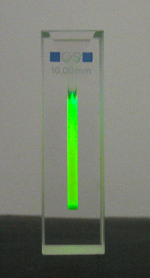Young researcher of the month
Our young researcher of the month is Jan Petersen, from Professor John Christie's lab. Jan is currently working in Professor Christie's lab as a researcher in the Plant Science group
Current research
Light is important for plant growth as it is a major source of energy to build up organic matter. For this reason plants contain several different photoreceptors that help them to adapt to diverse light conditions, adjust their development and as an outcome perform photosynthesis in the most efficient way in a changing environment.
One of these photoreceptor proteins is phototropin that senses blue wavelengths of visible light. Phototropin signalling serves to adjust the directional growth (tropism) of plant stems towards light. Apart from this phototropin is involved in a wide range of other processes that serve to optimise photosynthetic light capture and efficiency, including chloroplast re-localisation movements, leaf expansion and the opening of the stomata in the morning to promote CO2 uptake. My current research focuses on how the phototropin protein functions to activate such processes and whether this can be manipulated for agronomic gain.
The phototropin protein consist out of two light-sensing LOV-domains (light-oxygen voltage) that carry flavin mononucleotide as a chromophore in addition to a kinase domain that transmits the light stimulus into a biochemical signal by the phosphorylation of downstream targets to induce specific responses pathways.
A main part of my postdoctoral work has been to manipulate the activity of phototropin by engineering amino acid mutations into the light-sensing LOV domain to alter its photochemical activity and either decrease or increase phototropin function under specific light conditions. By doing so, we aim to alter plant growth with the intention to increase biomass production. We have successfully identified and tested different mutations that affect the photochemical reactivity for the LOV domain and have also investigated their impact on phototropin kinase activity in vitro. Studies are now aimed at determining whether these mutations within phototropin have any impact on plant growth by using the genetic model Arabidopsis thaliana. Next to manipulating the photocycle of phototropin, I have also worked on different collaborations that make use of the LOV domain either as a novel fluorescent reporter to track protein uptake into cells or as a light-inducible molecular switch for optogenetic applications. For one of these collaborations, I contributed to the first description of an engineered light-inducible potassium channel, which is a promising high impact tool for future neurophysiological research.
Next to manipulating the photocycle of phototropin, I have also worked on different collaborations that make use of the LOV domain either as a novel fluorescent reporter to track protein uptake into cells or as a light-inducible molecular switch for optogenetic applications. For one of these collaborations, I contributed to the first description of an engineered light-inducible potassium channel, which is a promising high impact tool for future neurophysiological research.
My experience
I obtained my PhD in Germany at the University of Bonn working on plant stress, in particular desiccation tolerance. During my doctoral thesis, I investigated the function of intrinsically disordered proteins that are induced during drought stress and established a biochemical screening/purification strategy to identify kinases that phosphorylate these proteins.
When I started in the group of Prof. John Christie at the University of Glasgow I was new to the field of photobiology. But with my skills in protein biochemistry it was easy for me to adapt to these new research challenges. Until now I gained hands on experience and knowledge in a wide range of techniques that will help me to accomplish research tasks in my future career as a scientist. Apart from my research to understand phototropin function in plants, I am especially fascinated by the prospects of using the LOV-domain as a light sensor and tool for optogenetics or synthetic biology applications. For this reason I especially enjoy the interdisciplinary collaborations where everybody contributes to different areas of expertise to produce an accomplished piece of research.

If you would like to feature on our young researcher of the month page, please contact Claire Osborne.

